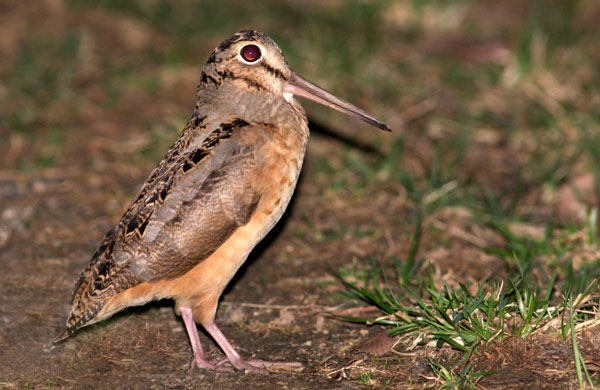

Photo Caption: Woodcocks, also known as timberdoodles, energize open fields at night in early spring with their whimsical courtship sounds.
February: The Wondrous, Whimsical Woodcock
By Dan Zarlenga, Missouri Department of Conservation
About the only thing stranger than how a timberdoodle looks, is the sounds it can make. Love makes one do strange things.
The American woodcock, also known as the timberdoodle, is a member of the sandpiper family. It’s a common migrant bird throughout much of Missouri, including in this area. Even though their cousins are shorebirds, woodcocks are definitely landlubbers. They typically live in open forests, woodlands near water, moist pastures, and forested floodplains.
Woodcocks are an awkward-looking bird, almost a foot in length. They have big black eyes and a comically-long bill. The woodcock is dark on the back, mottled with cinnamon and gray. Underneath, it’s a lighter, buffy color. Their appearance is a bit like that of a bird that just stepped out of a cartoon or a fantasy. But starting the latter part of February, woodcocks have a serious mission on their minds.
Woodcock mating season starts the first warm days or late February and carries on into March. You may not actually see their courtship ritual, because they are most active at dusk and early evening when light levels are low. But go to the right place, and you’re likely to hear it.
That place is often an open field bordered by trees. The ritual starts with the male strutting and “peenting” on the ground to catch the female’s attention. The peent is a short, nasal sound that might remind a listener of something almost electronic or mechanical.
After several short repetitions of this raspy sound, the male suddenly takes to the air in a wild spiral. As he does this, he emits another strange sound best described as a high-pitched twittering. It’s a haunting, fantastical noise, made even more unusual as the bird flies its spiral pattern in the dark. You might even think your ears are playing tricks on you. It then divebombs straight to the ground continuing the unusual sound, which is created by wind passing through the bird’s feathers.
After this erratic display, the male woodcock resumes peenting, only to replay the whole cycle again and again before finally retiring for the night.
So, if you want to take a step into what sounds like a fantasy world, walk by a field later this month like one of the many on the August. A. Busch Memorial Conservation Area in St. Charles. Wait for darkness to begin descending, and the ground will start to sizzle with electric-sounding peents. The air comes to life with a whimsical twinkling of sound when the woodcocks ascend to their acrobatic antics. As it flutters through the darkness “doodling” with sound, you’ll know how the timberdoodle get its name.
Photo courtesy the Missouri Department of Conservation.


